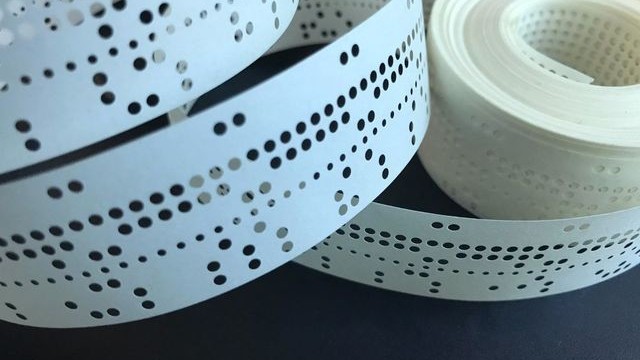
Cinta perforada
Launched: 1939
Capacity: Dependiendo de la longitud de la cinta.
Bit rate: 2500 caracteres ASCII por segundo (5000 en lectores ópticos)
Punched tape is a data storage method, consisting of a long strip of paper in which holes are made to store data.
It was widely used for much of the 20th century for teletype communications, and later as a data storage medium for minicomputers.
The first punched tapes were used in power looms.
This led to the concept of communicating information not as a succession of individual cards but as a "continuous card" in the form of a long tape.
Data was represented by the presence or absence of a hole in the tape at a given position. The original tapes had five rows of holes for data, but later ones had six, seven, and eight rows.
An additional row of consecutive smaller holes served to drive the tape, usually with a toothed wheel.
The earliest character encoding standard was Baudot, which dates back to the 19th century and had five holes. Later standards, such as Fieldata and Flexowriter, had six holes. In the early 1960s, the American Standards Association (ASA) undertook a project to develop a universal code for data processing, which would become known as ASCII. This 7-level code was adopted by some teletypewriter manufacturers, such as AT&T (Teletype). Others, such as Telex, continued to use Baudot.
When the first minicomputers were created, most manufacturers took advantage of mass-produced ASCII teletypewriters (primarily the ASR33) as a low-cost solution for keyboard input and printed output. As a result, punched tape became a popular low-cost storage medium, and it was not uncommon to find a selection of tapes containing useful programs in most minicomputer installations. Faster optical readers were also common.
The Facit 4070 punch model and other Diehl brand punches were common.
Working with tapes had some drawbacks:
It was common practice to manually go over each mechanical copy of a tape, comparing the holes one by one.
Tape rewinding was complicated and a source of problems. Great care was required to avoid tearing the tape. Some systems used fan-fold paper tapes instead of rolled paper tapes. In these systems, there was no need to rewind or use an extra take-up reel, nor were any mechanisms required to maintain tension; the tape simply passed from the container provided to the reader, to the reader, and from there to the take-up container, rewinding itself and remaining exactly as it had entered the reader.